Mark Sisson's Blog, page 37
October 15, 2021
New and Noteworthy: What I Read This Week—Edition 150
 Research of the Week
Research of the Week
Higher free PUFA in the blood, lower cognitive function.
London’s Black Cabbies have enlarged hippocampuses.
Low protein intakes make nighttime light exposure even more detrimental.
Essential oils show promise for improving mental health.
Those who laugh the most talking to a stranger enjoy the conversation least.
New Primal Kitchen PodcastsEpisode 2: Personalize Your Diet with Microbiome Expert Dr. Tim Spector: Morgan talks to Dr. Tim Spector.
Health Coach Radio: Annie Schuessler thinks that perfectionism doesn’t lead to excellence, but rather to waiting.
Media, Schmedia
I think we can all relate.
FDA putting the clamps on salt intake.
Interesting Blog PostsYes, this is true.
Average guy vs 100 mph fastball.
Social NotesEverything ElseThe mysterious Irish sweathouse.
Reminder that America is big.
Things I’m Up to and Interested InThis slipped under the radar: The COVID spike protein bears remarkable resemblance to the human protein hepcidin, which regulates iron metabolism.
Interesting changes coming: Health care workers are quitting in droves.
Common finding: “Finally, the rate of all-cause mortality had started to diverge in favor of placebo after 2 years of follow-up.”
Interesting video: What is fat for?
Wait for it: My guess is this “cholesterol game-changer” will end up increasing mortality.
Question I’m AskingWould you support a mandate for regular exercise?
Recipe CornerLemongrass pork skewers, Vietnam-style.Squash is incredibly nutritious, and this acorn squash with yogurt tahini dressing is incredibly delicious.Time CapsuleOne year ago (Oct 9 – Oct 15)
Starting Solids: When Can Babies Eat Table Food?— When?How to Eat More Organ Meat — How?Comment of the Week
“I read “Sometimes a Great Notion” in the 70’s, promptly suspended college and worked in the woods for almost 2 years. Got a job with a small outfit in Happy Camp, CA and when they expanded, I worked with them hooking logs to the bottom of helicopters. The experience was transformational. The hard work ethic has kept me thriving all these years.”
-Fiction can be powerful!
(function($) { $("#dfInnVB").load("https://www.marksdailyapple.com/wp-ad..." ); })( jQuery ); 
The post New and Noteworthy: What I Read This Week—Edition 150 appeared first on Mark's Daily Apple.



Ask a Health Coach: Why Can’t I Sleep?
 Hello folks! Seasoned health coach and Primal Health Coach Institute Curriculum Director, Erin Power is back to answer all your questions about sleep, from why you’re waking up in the middle of the night to the best natural ways to improve your sleep cycle. Got more questions? Post them over in our Mark’s Daily Apple Facebook group or down in the comments below.
Hello folks! Seasoned health coach and Primal Health Coach Institute Curriculum Director, Erin Power is back to answer all your questions about sleep, from why you’re waking up in the middle of the night to the best natural ways to improve your sleep cycle. Got more questions? Post them over in our Mark’s Daily Apple Facebook group or down in the comments below.
Jordan asked:
“I’ve been going to bed at 10 p.m. and waking up at 6 a.m. for a few weeks. For some reason, I’ve started waking at 3:15 a.m. and can’t go back to sleep. Any ideas on what’s causing it?”
Almost half of all adults struggle with insomniahttps://www.sleepfoundation.org/how-s... to some degree, so, if it’s any consolation, you’re in good company. That being said, it’s not ideal to feel like you’re dragging yourself around all day, coping with sugar-laden snacks or venti-sized cups of coffee.
One of two nights of suboptimal sleep are manageable. But when it’s a nightly occurrence? It’s time to dig a little deeper.
What Waking Up Early Really MeansAccording to Traditional Chinese Medicine,https://en.wikipedia.org/wiki/Traditi... waking up at a specific time of the night (or early morning in your case) is a sign that something is off in the body since, as TCM teaches, different hours are associated with different organs and emotional states. Even if you don’t follow that train of thought, paying attention to your body’s signals can be a huge wake-up call (no pun intended).
It sounds like these 3 a.m. awakenings are a new thing, so start by looking at what’s changed recently.
Are you:
Anytime you’re doing something that’s working, then suddenly it’s not working, it’s usually because some other element has changed. I know, this isn’t rocket science, but in health coaching we like to start with the obvious. I like to start with the lowest-hanging fruit, which in my experience, is quite often a change in stress levels.
When you go to bed at night and life’s other distractions have quieted down, the brain shifts into repair mode, and one of the tendencies that’s somewhat inherent to that is processing the worries of the day. While you might fall asleep with ease, your 3 a.m. jolt could be caused by an activation of your sympathetic nervous system. Maybe you feel your heart rate increase or your thoughts start racing. If this is the case with you, be aware of what might be causing your stress and take steps to alleviate it before your head hits the pillow.
When Blood Sugar is to Blame
Another thing to look at is blood sugar balance, which is can also be a culprit for 3 a.m. wake ups. It’s well established that high carbohydrate intake has been shown to increase the number of times a person wakes at night and reduces the amount of deep sleep.https://www.sleepfoundation.org/nutri... If you’re used to using carbs as fuel and eating every few hours, blood sugar can drop during the night because your body isn’t getting the constant glucose drip it’s receiving during the day. It’s just one of the reasons I’m a huge advocate for getting off the Standard American Diet and snacking rollercoaster.
High carb isn’t always to blame though. One study showed that a lower carbohydrate diet could also impact sleep due to low levels of serotonin and melatonin.https://pubmed.ncbi.nlm.nih.gov/23419... Researchers found that diets that were less than 50% carbs were linked to difficulty staying asleep — especially in men. There’s also proof that some people who ate low carb are more prone to experiencing sleep apnea.https://onlinelibrary.wiley.com/doi/f...
Take an honest look and get clear on what’s changed in the past week or so. If you’re under more stress, eating more carbs, or starting a diet like keto, get curious about what you can do to keep sleeping through the wee hours.
Tim asked:
“I’m lacking energy and am generally tired most of the day. According to my Fitbit, my sleep quantity is good, but my sleep quality is poor. I eat primal 95% of the time, though I’m not really trying to eat low carb. I supplement with magnesium, fermented cod liver oil, fermented skate liver oil, kelp, and probiotics. I do drink two large cups of butter blended coffee in the morning that’s half decaf, and I’m not getting much sunlight exposure these days, except for a dog walk at lunch. Other than ditching the coffee, any suggestions on how to improve my deep and REM sleep?”
First of all, Mark has shared sleep tips and written about how to crush some quality sleep quite often, and he’s always my go-to guy for information. But one of the things that jumps out at me from your question is that you acknowledge that you aren’t getting much sunlight exposure these days.
Sunlight exposure throughout the day is essential for syncing up our circadian rhythm, which has an important impact on sleep quality. This is one of the concepts I most love teaching my health coaching clients, because the notion that we need to engage with the sun at various times of the day is just so… natural. And, remember: we are nature.
Specifically, spending a few moments looking at early day sunlight helps encourage the onset of serotonin, the wakefulness hormone. Catching the mid-day rays during your lunchtime dog walk is great: it tells your body that the day is about half over. Finally, getting some exposure to the amber light of sunset tells the body to pack serotonin away and start thinking about churning out some melatonin — the sleep hormone.
Adding a morning walk and an after-dinner walk — just 15 minutes or so — is a simple way to spend just enough time in morning and evening sunlight, respectively, so you can get your sleep-wake hormones purring like a kitten.
And here are some more good ideas:
Wear Blue BlockersArtificial light from computers, tablets, and phone screens messes with your circadian rhythm, so if you need to finish work late at night or can’t stop scrolling social media, put on a pair of blue light blocking glasses to help reduce the impact on your sleep cycle.Get Black-Out Blinds
Even a small amount of light can disrupt your sleep. Black-out blinds are a great solution for the summer months, but can also be a huge help year-round. If new window coverings aren’t in the cards, get yourself a sleep mask.Turn Down the Thermostat
Your body temperature always rises at night, so keep your room cool (between 60-67?F / 15.6-19.4?C) to prevent overheating. Or get yourself a ChiliPAD. You won’t be sorry. I absolutely love mine.Skip the Drink
You might be tempted to wind down with a fine glass of Rioja, but alcohol late at night can interrupt your REM cycle too, leaving you feeling drained and groggy the next day. Alcohol can also cause you to snore more. Something to keep in mind if you care about the person sleeping next to you.Keep your Phone Away
In addition to emitting low levels of blue light, the temptation to respond to emails, check your Instagram feed, or make late-night purchases can be hard to resist when your phone is sitting right there on the bedside table. Instead, put it out of arm’s reach, preferably in the next room.
Ali asked:
“What are the best sleep supplements that don’t include magnesium or melatonin?”
Ask most people what they use for a natural sleep aid, and chances are you’ll be overwhelmed by folks singing the praises of magnesium and melatonin. And for good reason as they relax nerves and muscles, and help adjust your circadian rhythm, respectively.
As a health coach, it’s not in my practice to recommend specific supplements (although Mark has a great article about a few of them here), but if you ask me, there are even better sleep aid solutions that don’t require popping a pill.
Natural Sleep Remedies That Aren’t SupplementsIf you’re open to the idea that you shouldn’t have to take something to get your body and mind to unwind, try deep breathing and meditation – two of my favorite relaxation techniques.
Most of us have the habit of taking quick or shallow breaths. Or worse, completely holding our breath for periods of time. When you’re getting ready for bed tonight, spend a few minutes taking slow, deep breaths, in and out from your belly. This naturally causes you to relax, which reduces the stress hormones that block melatonin (and prevent you from getting a solid night of shut eye).
Doing a body scan can also help. This is type of mindful meditation combines breathwork with consciously relaxing your muscles. When you’re ready to give it a go, lie down in a quiet, comfortable place, starting at your head and working down to your toes. Notice any areas of tension you’re feeling, then direct your breath to that spot. Research backs it up too, saying that doing a 20-minute body scan before bed can help you sleep longer and wake up less frequently during the night.https://link.springer.com/article/10....
What’s your go-to for a better night’s sleep? Tell me in the comments below.
(function($) { $("#dfEjM4U").load("https://www.marksdailyapple.com/wp-ad..." ); })( jQuery );
The post Ask a Health Coach: Why Can’t I Sleep? appeared first on Mark's Daily Apple.



October 13, 2021
Is Soy Bad For You?
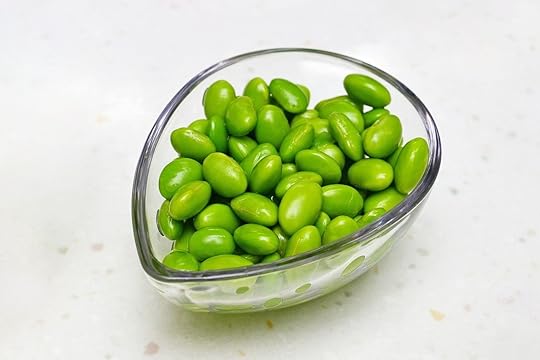 The Primal Blueprint classically recommends against legume consumption, but that stance has softened. Legumes aren’t bad in and of themselves. Many people have intolerance issues with them, and unresolved gut barrier leakiness or FODMAP intolerances can make legumes a painful, often cacaphonous indulgence. But the category of legume itself is not a simple thing. Some legumes are better than others. Some people will tolerate one legume but not another. So where does soy fit in?
The Primal Blueprint classically recommends against legume consumption, but that stance has softened. Legumes aren’t bad in and of themselves. Many people have intolerance issues with them, and unresolved gut barrier leakiness or FODMAP intolerances can make legumes a painful, often cacaphonous indulgence. But the category of legume itself is not a simple thing. Some legumes are better than others. Some people will tolerate one legume but not another. So where does soy fit in?
Well, there are a lot of foods that fall under “soy.” There’s soybean oil, soy protein, soy milk. There’s natto, tempeh, soy sauce. There’s the whole young soybean steamed. There’s the dried soybean cooked like a common bean. Anyway, let’s get on with things and analyze all the soy products available.
Soybean OilSoybean oil might be the single biggest impediment to human health in the modern world. Over the past century, our consumption of soybean oil has skyrocketed and the proportion of linoleic acid in human body fat has also risen. Seeing as how the absolute amount of body fat has increased as well, we’re looking at a huge rise in absolute amounts of linoleic acid in the human body. Body fat isn’t inert. It’s a legitimate endocrine hormone, and the type of fat you store on your body can determine your hormonal output and metabolic health.
This rise in soybean oil-induced linoleic-rich body fat has paralleled the increases in obesity, diabetes, heart disease, and all the other degenerative maladies of modernity you see walking around in everyday life.
Soybean oil isn’t “meant” to be consumed because it wouldn’t even exist as a product without industrial extraction methods. You can’t press a soybean and get extra virgin soybean oil. You need solvents and industrial-scale equipment to make soybean oil. This alone is a good indicator that we should not be eating it. And then there are the studies that confirm we shouldn’t:
Soybean oil has low oxidative stability—heat damages it rather quickly and easily.https://pubmed.ncbi.nlm.nih.gov/33096...
Soybean oil-based infant formulas are among the worst, producing poor metabolic and growth outcomes.https://pubmed.ncbi.nlm.nih.gov/26980...
Soybean oil combined with dietary cholesterol damages the liver. Lard combined with dietary cholesterol does not.https://pubmed.ncbi.nlm.nih.gov/30231...
The stuff is awful. Avoid.
Soy Protein
Soy protein powder has long been the go-to for plant-based lifters who want to increase their protein intake but can’t eat more animal protein to make it happen. If that’s your only option, fine: it’s better than not eating any extra protein. But if have no qualms about whey protein and you’re only choosing soy protein because it’s “healthier” or “better for the environment,” you’re making a big mistake.
Compared to whey and other animal proteins, soy protein is simply not as effective at stimulating muscle protein synthesis.https://pubmed.ncbi.nlm.nih.gov/20368... skim milk beats soy protein drink for muscle protein synthesis.https://pubmed.ncbi.nlm.nih.gov/17413... milk leads to better lean mass gains than soy protein.https://pubmed.ncbi.nlm.nih.gov/17684... men drinking whey protein after lifting weights make more gains than young men drinking soy protein after lifting weights.https://pubmed.ncbi.nlm.nih.gov/19589... dialysis patients looking to reduce lean mass loss, whey works better than soy.https://pubmed.ncbi.nlm.nih.gov/34458...One study in college aged men found that while milk protein enhanced hypertrophy in type 2 fast twitch fibers, soy protein enhanced hypertrophy in type 1 fibers. If you want to get “jacked,” type 2 fibers are what you want to grow.https://pubmed.ncbi.nlm.nih.gov/30042...
Whey is simply whey better than soy protein.
Soy MilkBelieve it or not, of all the popular non-dairy milks out there, soy milk contains the most nutrients and is probably the closest to cow milk. It’s high in protein. It contains a nice balanced selection of minerals. A review comparing soy milk, coconut milk, almond milk, and rice milk to cow milk found that soy milk was the closest—mostly because it actually featured measurable nutrients.
A cup of soy milk
74 calories3.6 g carbs; 2 g fiber4 g fat8 g proteinAll the usual additions, like calcium, vitamin B12, vitamin D, riboflavin, and vitamin A10% magnesium15% manganese6% folate6% potassium19% copper10% seleniumLooks good on paper and is certainly better than the other alternatives, which are pretty much just nut water. However, people who regularly drink soy milk tend to end up with micronutrient deficiencies possibly due to the phytic acid levels inhibiting mineral absorption.https://www.ncbi.nlm.nih.gov/pubmed/2... Another possibility is that the soy milk is causing leaky gut, which inhibits nutrient absorption. Kids who drink cow milk are less likely to have atopic eczema, while soy milk drinkers have no such protection (and may even have increased risk). The protein in soy milk can help people build muscle, but milk proteins work better and also provide other benefits to the immune system. Soy is also notorious for harmful farming practices and requires copious amounts of chemical sprays, which are harmful to the consumer and to the environment.
Fresh Soybeans (edamame)Edamame are young soy beans, still in the pods. They are not eaten raw, but they don’t require a lot of cooking. A light steam (or run through the microwave, as sushi restaurants do) will sufficiently tenderize the little beans. These aren’t hardy, difficult-to-digest dried beans. They’re more like green peas or green beans, which I previously gave the stamp of approval.
The fatty acids in edamame are mostly monounsaturated (which we like), whereas soybean oil, as mentioned earlier, is mostly polyunsaturated linoleic acid (which we usually want to reduce).
Edamame actually have drastically lower levels of phytoestrogens than mature soybeans. One study found that the phytoestrogen content of edamame samples ranged from 0.02% to 0.12%, while mature soybean samples ranged from 0.16% to 0.25%.https://www.ncbi.nlm.nih.gov/pubmed/1... The gulf widens when you consider that edamame are a snack, eaten sparingly, while mature soybeans are usually converted into tofu, soymilk, and other products that people consume in large amounts.
I couldn’t find solid data on phytic acid levels in edamame, but that could be an indication of researchers’ utter lack of concern for the levels of phytic acid in edamame. I’d imagine that the phytic acid situation is much like the phytic acid situation in other young legumes like green peas and green beans: not very dire.
While I wouldn’t make it a regular part of my diet, edamame appears to be relatively benign as an occasional snack. Just don’t eat bucketfuls, don’t make it baby’s first food, and don’t get into edamame pancakes or some silliness like that.
NattoEven though natto is soybeans, a legume with significant levels of phytoestrogens, phytic acid, and trypsin inhibitors, with a gross, slimy texture that may be outdone only by its interesting taste, it’s not what you think. By most accounts, people following a Primal lifestyle shouldn’t have anything to do with it. If you asked me ten years ago, I may have said that. But natto is a special kind of soy. It’s fermented using a particular strain of bacterium called Bacillus subtilis natto. When steamed soybeans are inoculated with b. subtilis, they are transformed from a basic legume with few redeeming qualities into a powerful supplemental food imbued with high levels of vitamin K2, a nutrient important in bone mineralization, cancer prevention, and protection from heart disease. The fermentation also makes it more digestible and reduces the phytic acid content.
Natto is great. Eat it. If you don’t like the taste, try eating it with soy sauce/tamari, black garlic, smoked oysters, sardines, a raw egg yolk, and maybe a little rice (or cauliflower rice).
Soy SauceReal soy sauce is naturally brewed/fermented. Look out for the acid-hydrolyzed soy protein sauce masquerading as real soy sauce.
I’ve gotten in trouble for this before, so I’ll make it clear this time: if you are celiac or have a sensitivity to gluten, choose tamari-style soy sauce (and make sure it says “gluten-free,” as some types of tamari just use less wheat than normal soy sauce). For the rest of us, I don’t think a few dabs of soy sauce will hurt. I’m normally quite sensitive to large doses of gluten—I can get away with a crust or two of bread with butter and that’s it—and regular soy sauce doesn’t bother me. But, again, if you have a negative response to soy sauce, use gluten-free tamari instead. Some research even shows that celiac patients can tolerate real fermented soy sauce, even the stuff that contains wheat.
A review found that soy sauce improves digestion by increasing gastric juice secretion (good, since we typically have it with food), inhibits microbial growth, contains an anti-hypertensive component, displays anti-cancer qualities, and has “shoyuflavones” with anti-inflammatory effects.https://www.ncbi.nlm.nih.gov/pubmed/1... Soy sauce also contains polysaccharides that may increase iron absorption and reduce the symptoms of hay fever.https://www.ncbi.nlm.nih.gov/pubmed/1...https://www.ncbi.nlm.nih.gov/pubmed/1... Real, fermented soy sauce has an antioxidant profile easily outclassing red wine, with one study finding that a single meal containing soy sauce reduced oxidative stress, lowered diastolic blood pressure, and inhibited lipid peroxidation in adults.
Soy sauce is good.
Soy LecithinSoy lecithin is simply the byproduct of soy oil extraction. It’s not hydrogenated soybean oil, folks allergic to soy can eat it without ill effect, and lecithin actually contains choline and phospholipids that can be quite beneficial for liver health.https://www.ncbi.nlm.nih.gov/pubmed/1... Don’t go out of your way to eat soy lecithin for any health benefits (egg yolks and liver are far better sources of choline), but don’t pass on some excellent dark chocolate simply because “soy” appears on the package.
For what it’s worth, high dose soy lecithin has been shown to increase vigor and improve blood pressure in post-menopausal women.https://pubmed.ncbi.nlm.nih.gov/29310...
Soy lecithin isn’t anything to worry about.
What about some of the health effects of soy consumption?
Soy and CancerWe’re talking mostly about breast cancer here. The culprit in question is the group of soy isoflavones, plant hormones that mimics estrogen in the body. Some research has shown that isolated isoflavones, a.k.a. phytoestrogens, contribute to the growth of tumors in the breast, endometrium and uterus.
It essentially comes back to the whole foods question. The research has focused on the isolated isoflavones, particularly genistein, the most active of the soy isoflavones that activates cellular estrogen receptors, including those in breast tumors. Noted experts in the field have cautioned that research with isolated soy compounds does not necessarily carry over well to the effect of the whole food, even minimally processed soy flour. In other words, soy is healthier than the sum of its parts. Other studies have shown that the mix of phytoestrogens in soy, when taken together in whole soy foods, protect estrogen receptors and may partly shield them from the estrogen we take in with meat and dairy consumption (yup, bovine hormones even in organic). They can also possibly reduce the impact of the unequivocally insidious “xenoestrogens” found in chemical pollutants.
Add to this picture the analysis of cultural diet and disease trends. Though Japanese women regularly eat significant portions of soy (in forms like tempeh, edamame, miso and tofu), they have only 1/5 of the breast cancer rate that Western women have. There are other differences, of course, but the fact remains that soy consumption doesn’t seem to be increasing the rate of breast cancer.
Soy and Thyroid FunctionResearchers are in general agreement that people with previously diagnosed hypothyroidism (underactive thyroid) should not take soy supplements or make soy a large part of their diet. The isoflavones in soy inhibit thyroid peroxidase, which produces the thyroid hormones T3 and T4, which can make a bad situation worse for those with diagnosed hypothyroidism or can inhibit thyroid function in an otherwise healthy person.
In countries that do consume a lot of soy, they also tend to consume a lot of seaweed, which is rich in iodine and can counter the inhibitory effects on thyroid function. If you’re going to consume soybeans, make sure you consume seaweed or get plenty of iodine from other sources like shellfish and seafood.
Soy and Mineral AbsorptionSoybeans are high in phytic acid, which is known to block the body’s absorption of minerals such as calcium, zinc magnesium and iron, just like grain-based diets have been shown to do. Fermentation is known to substantially reduce phytate levels, which is why you often hear that fermented soy forms are preferable—and it’s why most cultures who consumed soy as a staple food did so by fermenting it.
Soy and TestosteroneAlthough some recent reviews claim to have found “no effect,” one study found that 14 days of soy protein feeding was enough to suppress testosterone levels in young men.https://pubmed.ncbi.nlm.nih.gov/24015...
And every case study I’ve ever run on the subject, by which I mean listening in on what people in line at the cafe are ordering and comparing their physiques, men who order soy milk lattes tend to have skinny fat bodies and burgeoning breasts.
What’s the Bottom Line on Soy?Whole and fermented soy forms are clearly preferable. Personally, I wouldn’t bother with anything else. There are far better alternatives to most soy products:
Real milk beats soy milk.
Whey protein beats soy protein.
Avocado oil, olive oil, and animal fats beat soybean oil.
However, soy sauce/tamari is tough to replace. Luckily, it’s pretty inoffensive and may even be good for you.
Natto is impossible to replace. Best source of vitamin K2 on the planet.
Soy lecithin really helps smooth out high quality dark chocolate and is pretty benign.
I think there is something to the benefits of whole fermented soy, not as a staple but as a condiment or supplemental food, especially when combined with seaweed or another source of iodine. Nonetheless, you should all avoid soybean oil, soy protein, and any isolated concentrated “extract” of soy. And if you have any issues with testosterone, or you want to build yours to great heights, take it easy on the soy.
Kids shouldn’t eat large amounts of soy beyond some edamame at the sushi bar or some natto in their lunch plate.
Babies shouldn’t eat soy at all, especially not in formula form.
Above all else, soy isn’t necessary to be healthy, and a lot of it will probably lower your quality of life and general vigor. There may be genetic factors at work here, too, where populations with a long history of soy consumption can benefit more than people whose ancestry does not record much soy exposure. And even there, those people weren’t eating soy protein isolate and soybean oil.
What do you think of soy, folks? Do you eat it at all? If so, in what forms?
(function($) { $("#dfRovbY").load("https://www.marksdailyapple.com/wp-ad..." ); })( jQuery ); 
The post Is Soy Bad For You? appeared first on Mark's Daily Apple.



October 12, 2021
How to Eat Enough Protein
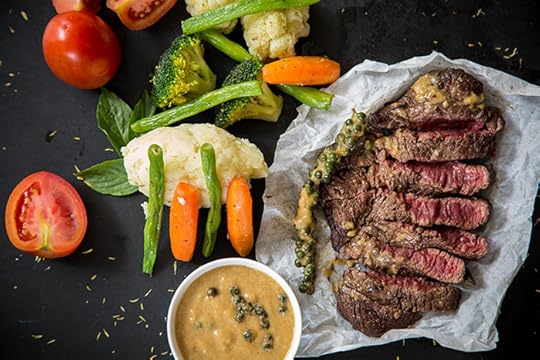 As I discussed in a recent post, my diet has been trending toward a higher protein intake than in years past. Rarely do I consume less than 100 grams of protein. Most days I’m considerably higher even eating only two meals. Those meals center around protein first and foremost with vegetables playing more of a supportive role.
As I discussed in a recent post, my diet has been trending toward a higher protein intake than in years past. Rarely do I consume less than 100 grams of protein. Most days I’m considerably higher even eating only two meals. Those meals center around protein first and foremost with vegetables playing more of a supportive role.
After so many years of following a Primal diet, I feel wholly confident in my ability to eat intuitively. I trust my body to guide my food decisions from meal to meal, day to day, and week to week, so I don’t bother with tracking macros (the exact amounts of protein, carbs, and fat I eat each day). However, knowledge is power. You should have a sense of your protein and carb intake at least, even you’re getting even if you ballpark it.
Most folks don’t have a clue what they’re eating, though. Sure, they might read nutrition labels at the supermarket, but how many people know what 100-150 grams of protein look like in terms of actual food? Do you know how much protein is in a single chicken breast? How about a six-ounce steak? Three eggs, handful of nuts, or even vegetables?
How to Measure Protein IntakeProtein is measured by the gram weight of the protein itself, not the total volume of food you eat. This is a common point of confusion for people who are new to tracking their food. As you’ll see, four ounces of steak is different protein-wise than four ounces of chicken breast or salmon. To determine how much protein a given food contains, you’ll need an app like Cronometer (my current favorite) plus a food scale for precision. Measure all meat raw and make sure to select the correct entry (raw versus cooked) in your tracking app.
Even if you don’t want to weigh and measure all your food, consider tracking just your protein intake for a few days. See what you’re averaging. In my experience, almost everyone is eating less than they think, especially if they practice intermittent fasting. Once you have a decent sense of what it takes to hit your daily protein goal, it’s up to you whether you want to continue to track or not.
I’ll save you some time and provide protein data for a bunch of common foods below. All values came from Cronometer. You’ll notice right away that this list includes both animal- and plant-based sources of protein, including things like legumes and soy products that aren’t strictly Primal. Don’t take this to mean that I think animal and plant sources of protein are equivalent. There’s no question that animal-based proteins are superior in terms of bioavailability and amino acid profiles. However, our Primal community includes individuals who self-identify as plant-based, vegetarian, or even vegan. I want them to eat enough protein, too, from the best possible sources. I’ve thoroughly covered the question of plant-based diets vis a vis Primal Blueprint recommendations in the past. Scroll to the end of the post for further reading on the topic.
How Much Protein Is in Meat?
Values provided for raw meat by weight.
Ground beef, 85% lean (4 oz.): 21 grams
Ground turkey, 93% lean (4 oz.): 21 grams
Chicken breast, boneless (4 oz.): 26 grams
Chicken thighs, boneless (4 oz.): 23 grams
Turkey breast (4 oz.): 26 grams
Porkchop (4 oz.): 25 grams
Pork shoulder (4 oz.): 21 grams
Steak, New York strip (4 oz.): 25 grams
Steak, ribeye (4 oz.): 22 grams
Ham (4 oz.): 23 grams
Venison (4 oz.): 24 grams
Beef liver (4 oz.): 23 grams
Beef heart (4 oz.): 21 grams
Beef tongue (4 oz.): 20 grams
Protein in SeafoodTuna, fresh (4 oz.): 28 grams
Salmon (4 oz.): 25 grams
Pollock (4 oz.): 22 grams
Trout (4 oz.): 23 grams
Oysters (4 oz.): 11 grams
Shrimp (4 oz.): 15 grams
Canned tuna (1 5-oz. can): 36 grams
Canned sardines (1 4.4-oz. can): 17 grams
Protein in Common Dairy ProductsCottage cheese, full-fat, plain (1 cup): 23 grams
Cottage cheese, fat-free, plain (1 cup): 22 grams
Greek yogurt, full-fat, plain (1 cup): 22 grams
Greek yogurt, fat-free, plain (1 cup): 25 grams
Whole milk (1 cup): 8 grams
Skim milk (1 cup): 8 grams
Heavy whipping cream (2 Tbsp.): 1 gram
Cheddar cheese (1 oz.): 7 grams
Swiss cheese (1 oz.): 8 grams
Cream cheese, full-fat (1 oz.): 2 grams
Are Eggs High in Protein?Chicken egg (1 large): 6 grams
Duck egg (1): 9 grams
Quail egg (1): 1 gram
Plant-based Protein: Legumes and SoyTofu, firm (4 oz.): 14 grams
Tempeh (4 oz.): 23 grams
Natto (4 oz.): 22 grams
Lentils (1/2 cup cooked): 9 grams
Split peas (1/2 cup cooked): 8 grams
Black beans (1/2 cup cooked): 8 grams
Kidney beans (1/2 cup cooked): 8 grams
Pinto beans (1/2 cup cooked): 8 grams
Chickpeas, aka garbanzo beans (1/2 cup cooked): 7 grams
Green peas (1/2 cup): 4 grams
Nuts and SeedsPeanut Butter (2 Tbsp.): 7 grams
Almond Butter (2 Tbsp.): 7 grams
Almonds (1 oz.): 6 grams
Cashews (1 oz.): 5 grams
Macadamias (1 oz.): 2 grams
Walnuts (1 oz.): 4 grams
Chia seeds (1 oz.): 5 grams
Flax seeds (1 oz.): 5 grams
Hemp seeds (1 oz.): 9 grams
Pumpkin seeds (1 oz.): 9 grams
Sesame Seeds (1 oz.): 6 grams
Sunflower seeds (1 oz.): 6 grams
Fruits and Vegetables with the Most ProteinSpirulina powder (2 Tbsp.): 12 grams
Brussels sprouts (1 cup): 4 grams
Broccoli florets (1 cup): 3 grams
Asparagus (4 large spears): 2 grams
Green beans (1 cup): 2 grams
Spinach, raw (1 cup): 1 gram
White potatoes (1 medium): 4 grams
Sweet potatoes (1 medium): 2 grams
Blackberries (1 cup): 2 grams
Guava (1 fruit): 1-2 grams
Gluten-free Ancient Grains, Pseudograins, GrassesTeff (1/2 cup cooked): 5 grams
Amaranth (1/2 cup cooked): 5 grams
Quinoa (1/2 cup cooked): 4 grams
Wild rice (1/2 cup cooked): 3 grams
This is obviously not a complete list of every protein-containing you might eat. Protein powders, especially whey protein, are convenient and usually highly bioavailable sources of essential amino acids. I didn’t include them here because protein content varies by brand, but you can usually expect 20-30 grams per serving. I also avoided the bevy of fake meat alternatives. In part that’s because they also vary widely in protein offerings, but more to the point, many of them contain objectionable ingredients such that I can’t in good conscience list them here.
Finally, let me put in a plug for looking seriously at insects as an option. Unless you grew up in a culture that values insects as a food staple, you’re probably shaking your head right now, but insects win big points both for sustainability and nutrition!
Check out our recipe collection for tons of fantastic ideas for protein-centered meals.
Further Reading17 Primal Tips for Vegans and VegetariansLow Carb Vegan: Is Plant-based Keto Possible?What Primal Types Can Learn from Plant-Based Diets (and Dieters)Whey Protein vs. Pea ProteinProtein FAQHow much protein do I need?A good rule of thumb is to aim for a minimum of 0.7 to 1 gram per pound of lean body mass for overall health. For building muscle, research suggests 0.8 g/lb (1.6 g/kg) of body weight is a good target.
How much protein is too much?There’s not really an upper limit, though at some point you start to get diminishing returns. The myth that you shouldn’t consume more 30 grams of protein at a time because that’s all your body can assimilate is just that – a myth.
Is protein powder good for you?While I generally recommend opting for whole foods first, protein powders can provide convenient options for meal replacements or snacks. Whey protein is the most bioavailable. Even though it is derived from dairy, many people who are lactose intolerant tolerate whey protein powders.
Best vegan protein sources?It’s extremely difficult to be both vegan and Primal. Most vegan-friendly foods that contain non-negligible protein are borderline Primal at best. That said, legumes, nuts, and seeds of all kinds, plus teff, quinoa, amaranth, and vegan protein powders will be your best bets.
The post How to Eat Enough Protein appeared first on Mark's Daily Apple.



October 9, 2021
Scotch Egg Style Mini Breakfast Meatloaf Recipe
These amazing egg-stuffed mini meatloaves aren’t only for breakfast. They’re great for lunch or dinner, too. But when served in the morning, they really start the day off right.
First, a mixture of pork and beef is seasoned to taste like breakfast sausage. Next, it only takes a minute to form the meat around a hardboiled egg. When baked together, the meat and egg turn into a rather stunning little loaf.
Cook these mini breakfast meatloaves on a lazy weekend morning, or better yet, on Sunday night so they’re waiting in the refrigerator Monday morning.


Preheat your oven to 350 degrees Fahrenheit.
In a bowl, combine the pork, beef, oil, onion, garlic, mustard, sage, egg and dried herbs and spices.
 Once everything is mixed together, separate the mixture into 6 balls.
Once everything is mixed together, separate the mixture into 6 balls.

Flatten each ball into a circle and place a peeled egg in the center. Wrap the egg in the meat mixture. Repeat with the remaining eggs.
 Brush half of the ketchup on top of each meatloaf.
Brush half of the ketchup on top of each meatloaf.

Bake for 20 minutes, then brush with the remaining ketchup. Bake for an additional 10 minutes, or until the meatloaves are browned and the internal temperature of the meat reaches 160 degrees Fahrenheit. Top with fresh thyme leaves and enjoy!
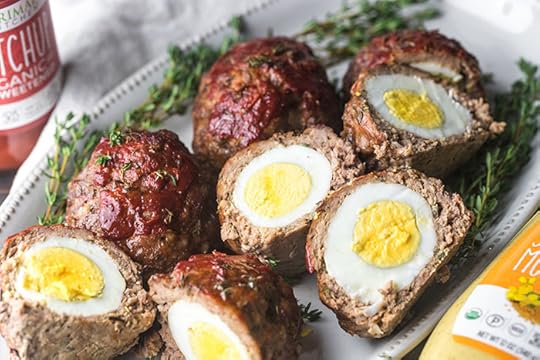
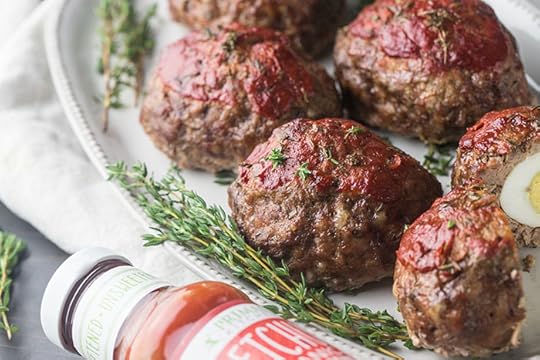

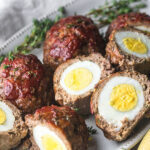 Scotch Egg Style Mini Meatloaf Recipe Author: Mark's Daily Apple
Scotch Egg Style Mini Meatloaf Recipe Author: Mark's Daily Apple  Prep Time: 15 minutes
Prep Time: 15 minutes  Cook Time: 20 minutes
Cook Time: 20 minutes  Total Time: 35 minutes
Total Time: 35 minutes  Yield: 6 servings Diet: Gluten Free [image error] Print Recipe [image error] Pin Recipe Description
Yield: 6 servings Diet: Gluten Free [image error] Print Recipe [image error] Pin Recipe Description Mini meatloaves made Scotch eggs style with a hard boiled egg in the center, topped with a ketchup glaze.
Ingredients6 peeled large hard-boiled eggs
1 lb. ground pork
1 lb. ground beef
1 tbsp. olive oil or avocado oil
1/2 cup minced onion
2 cloves minced garlic
2 tbsp. spicy or dijon mustard
1 tbsp. minced fresh sage
1 egg
1/2 tbsp. dried thyme
1 tsp. salt
1 tsp. garlic powder
1 tsp. paprika
1/2 tsp. black pepper
1/2 tsp. sweetener of choice
1/4–1/2 tsp. ground fennel
1/3 cup ketchup or spicy ketchup
Fresh thyme, for garnish
Preheat your oven to 350 degrees Fahrenheit.
In a bowl, combine the pork, beef, oil, onion, garlic, mustard, sage, egg and dried herbs and spices. Once everything is mixed together, separate the mixture into 6 balls.
Flatten each ball into a circle and place a peeled egg in the center. Wrap the egg in the meat mixture. Repeat with the remaining eggs. Brush half of the ketchup on top of each meatloaf.
Bake for 20 minutes, then brush with the remaining ketchup. Bake for an additional 10 minutes, or until the meatloaves are browned and the internal temperature of the meat reaches 160 degrees Fahrenheit. Top with fresh thyme leaves and enjoy!
NotesFollow the tips on how to hard-boil eggs in our egg tutorial
You can use all beef or all pork for this recipe if you’d like. Dark chicken meat would probably work as well.
 Category: Lunch, Dinner
Category: Lunch, Dinner Method: Baking
Method: Baking Cuisine: American Nutrition Serving Size: 1/6 of recipe Calories: 436.6 Sugar: 1.6 g Sodium: 882.9 mg Fat: 30.2 mg Saturated Fat: 6 g Unsaturated Fat: 2.87 g Trans Fat: .35 g Carbohydrates: 7.4 g Fiber: .8 g Protein: 33.7 g Cholesterol: 122.9 mg Net Carbs: 6.53 g
Cuisine: American Nutrition Serving Size: 1/6 of recipe Calories: 436.6 Sugar: 1.6 g Sodium: 882.9 mg Fat: 30.2 mg Saturated Fat: 6 g Unsaturated Fat: 2.87 g Trans Fat: .35 g Carbohydrates: 7.4 g Fiber: .8 g Protein: 33.7 g Cholesterol: 122.9 mg Net Carbs: 6.53 g Keywords: mini meatloaf recipe, mini meatloaves recipe, scotch eggs recipe
 Did you make this recipe?
Did you make this recipe? Share a photo and tag Mark's Daily Apple — we can't wait to see what you've made!
(function($) { $("#dfSCqll").load("https://www.marksdailyapple.com/wp-ad..." ); })( jQuery ); 
The post Scotch Egg Style Mini Breakfast Meatloaf Recipe appeared first on Mark's Daily Apple.



October 8, 2021
New and Noteworthy: What I Read This Week—Edition 149
 Research of the Week
Research of the Week
The people who need the vaccine most of all—the metabolically unhealthy—have the lowest antibody response to vaccination.
100% of Spanish breastfeeding women have elevated levels of acrylamide, a toxin caused by heating vegetable oils.
A high-soybean oil diet (sound familiar?) causes colitis in rodents.
Those who secrete the most insulin are more likely to lose more lean mass and less body fat during weight loss.
Breastfeeding on a ketogenic diet imparts high enough ketones in the milk to prevent seizures in the nursing baby.
New Primal Kitchen PodcastsEpisode 1: Mark Sisson and Morgan Zanotti: Morgan and I talk about the Primal Kitchen story.
Health Coach Radio: Dr. Shanté Cofield says the time will pass anyway, so why waste it?
Media, SchmediaWhat they don’t mention is that the same data shows that 49% of teen girls are anemic.
Gorilla dies in the arms of the ranger who first rescued her. Storybook ending, bittersweet.
Interesting Blog Posts
Some interesting ways to use potato starch in the kitchen.
Social NotesAre you putting mayo in your coffee yet?
Everything ElseBabies are full of microplastics.
Things I’m Up to and Interested InReminder: Selenium status is one of the best predictors of COVID mortality, and we’re doing nothing about it.
Like for like: Move your body, move your brain.
Interesting study: “COVID-19 vaccination and subsequent dishonest behavior.”
Big if true: Blood pressure drugs appear to offer no mortality benefit to patients aged 18-59 with mild to moderate hypertension.
What have I been saying?: Early screen time predicts myopia.
Question I’m AskingWhat’s your most important healthy behavior, the one with the most impact on your life?
Recipe CornerShrimp and avocado salad: and you thought salads were boring or nutrient-poor.Basic guac is best guac.Time CapsuleOne year ago (Oct 2 – Oct 8)
How to Eat Meat and Still Reduce Your Environmental Impact— It’s very possible.How to Foster Healthy Body Image in Children— How to do it.Comment of the Week
“I need fire to grow, also.
I need that passion that drives whatever I do to be something more than the simple act.
I need that burning desire to hold the woman I love with a jealous embrace.
I need the spark that pushes me to look over the distant horizon or to crest the next wave, and to experience the unknowable world beyond the familiar.
I need the drive to grow and shine and be better today than I was the day before.
I need water and nutrients, just as that sequoia does. Similarly, I need that fire to be more than simply alive.”
-Me too, hate_me.
(function($) { $("#dfF9cFf").load("https://www.marksdailyapple.com/wp-ad..." ); })( jQuery ); 
The post New and Noteworthy: What I Read This Week—Edition 149 appeared first on Mark's Daily Apple.



October 7, 2021
Why You Need to Believe It Before You Can See It
 We all love a good success story, don’t we? Hearing how someone dropped 70 pounds. Or got super fit. Or ditched their meds. They make it look so easy. Heck, all you have to do is clear out the pantry and stock it with primal-friendly foods and you’re golden.
We all love a good success story, don’t we? Hearing how someone dropped 70 pounds. Or got super fit. Or ditched their meds. They make it look so easy. Heck, all you have to do is clear out the pantry and stock it with primal-friendly foods and you’re golden.
Except that’s not how it works for most people. Most people operate from a point of view that prevents them from seeing the results they’re working so hard to obtain. How many times have you said to yourself, “I’ll be happy once I’m wearing a smaller size.” Or “When I lose the weight, I’ll be more confident.”
In my experience, the biggest difference between folks who continually crush their goals and those who always seem to have setbacks is that goal-crushers know how to tap into the feeling of having already achieved something great before that great thing actually happens.
Your Thoughts Create Your RealityIt’s time we change the conversation from “when I achieve my goal, I’ll feel good” to “when I start feeling good, I can achieve my goal.” Your thoughts are the biggest needle-mover when it comes to changing your reality. If you want a different life, a different pant size, a different relationship with food, you need to adjust your thoughts.
Easier said than done, right? If you’re new to this whole your-thoughts-create-your-reality thing, let me start by saying that it’s not your fault if you believe you really hate exercising or that you’re destined to battle sugar cravings for the rest of your days. ??We all have self-limiting beliefs. Even health coaches like me. As humans, we’re wired to create narratives based on pieces of information we picked up from childhood, from our family, friends, or our environment, about ourselves or how things are supposed to be. These narratives become a form of our identity. So, while you may believe you couldn’t cut out pizza and beer if your life depended on it, just know that it’s your belief system calling the shots, not the truth.
Why Self-Efficacy and Visualization Work
Every thought you think and action you perform is driven by a belief that a certain outcome is — or isn’t — possible. Psychologist Albert Bandura originally proposed the concept of self-efficacy, which refers to the idea that if you believe you can make a change, you’re much more likely to actually do it.https://en.wikipedia.org/wiki/Albert_...
Examples of Strong Self-efficacy:
Looking at challenging problems as tasks that can and should be masteredDeveloping a deeper, more committed interest in the activities you participate inFeeling a dedication to yourself and to your goals that doesn’t waver, even when the going gets toughHaving the ability to get back on track quickly after experiencing a setbackBased on this premise, author James Clear developed a concept he calls identity-based habits. It’s basically the idea that if you believe you’re the type of person who eats healthy or moves daily, it’s easier to change your behaviours, than say forcing yourself to pass on the rolls or go to the gym when you don’t want to.
And then there’s visualization. Long used by athletes, from weekend racers to Olympic gold medalists, visualization is a technique where you spend time practicing experiencing whatever it is that you want to achieve in your mind. That includes the big things like crossing the finish line, and smaller details like lacing up your shoes when it’s miserable out.
When you actively visualize what you want for yourself (and believe you can have it), you’ll start to notice more opportunities — and you’ll be more likely to persevere when things aren’t all rainbows and sunshine. According to the psychoneuromuscular theory, your neural pathways get programmed the same way whether you’re mentally performing an action or physically performing it.2
Mental Power to Muscle PowerYou’ve probably noticed times when your thoughts produce a physical reaction. Think about when you get nervous. Maybe you get a pit in your stomach or get “butterflies” when you’re excited, or your shoulders get tense when you feel stressed.
There are tons of studies that prove the power of the mind, including one published in Human Kinetics Journals, where researchers looked at the electromyographical activity (EMG) of 22 male and 17 female weightlifters and found that their muscles were activated (and their strength increased) just by imagining lifting weights.https://journals.humankinetics.com/co...
And in another study, where two groups were asked to perform “mental contractions” of their finger and elbow, while one group did the physical equivalent. Over the course of 12 weeks, the first two groups had increased their strength by up to 35% just by imagining doing the exercises, versus a 53% increase with the folks who performed them physically.https://pubmed.ncbi.nlm.nih.gov/14998...
How to Create a Believe-It-To-See-It MindsetCall it visualization, creation, or self-efficacy, the point is, your mind is an amazing tool for laying the groundwork for the life you want. If you’re open to the idea that you can believe it before you see it, check out these steps:
Get Out of Autopilot Mode.Our brains have an unconscious system for completing routine tasks. It’s just one of the ways it keeps us safe from being overloaded with decisions. The problem is, when we’re not consciously aware of what we’re doing (or what we’re thinking), we’ll keep doing and thinking the same thing day after day, which makes it hard to see anything that differs from your current reality.TRY THIS: Next time you’re about to perform a routine task, such as brushing your teeth or scrolling social media, use your non-dominant hand. This helps you stay in the moment and see things in different ways.Rehearse it Mentally.
This isn’t about daydreaming that you won the lottery or that you crossed the finish line at Boston. This is about mentally walking through the steps (and the ups and downs that might transpire) that get you to your goal. Basically, it’s a way to convince yourself in the safety of your mind that you are prepared for anything that might happen.TRY THIS: If weight loss is your goal, rehearse prepping a healthy breakfast when you’re short on time or navigating a party with limited food options. If your goal is to have more confidence, rehearse meeting new people — and feeling great about the interaction.Take Aligned Action.
Once you start believing that you can lose the weight, or talk to strangers in line at the store, or run a PR, you’ll instinctively want to act. Because you’ve seen it in your mind — and your neural pathways have started to become programmed as if you’ve been doing it — the steps you need to take will feel easier and more natural.TRY THIS: Begin with baby steps. Instead of focusing on the end goal, get present and check off the small tasks, like lacing up your running shoes in the morning, sitting down for an epic protein-packed breakfast, or asking a complete stranger how their day is going.It All Starts with Believing
If you’ve been operating from the point of view that you need to see to believe (and not getting the results you want), consider a different tactic. One that gets you tapped into the high vibrating feeling of achieving your goal by following these steps:
Get out of autopilot modeRehearse it mentallyTake aligned actionWhat about you? Do you need to see it first? Or are you all-in on believing?
(function($) { $("#dfwtL47").load("https://www.marksdailyapple.com/wp-ad..." ); })( jQuery );
The post Why You Need to Believe It Before You Can See It appeared first on Mark's Daily Apple.



October 6, 2021
Dairy and Its Effect on Insulin Secretion (and What It Means for Your Waistline)
 The relationship between dairy consumption, insulin, and our health can be confusing. It’s easy to see why: The most common types of dairy undeniably spike our insulin levels, and elevated insulin has been linked to dozens of diseases—most diseases, in fact. When insulin is high, your body holds onto body fat. And insulin resistance, which is when your body doesn’t respond to insulin and must release large amounts of the hormone, makes it harder to lose body fat and is the precipitating factor in a host of degenerative diseases.
The relationship between dairy consumption, insulin, and our health can be confusing. It’s easy to see why: The most common types of dairy undeniably spike our insulin levels, and elevated insulin has been linked to dozens of diseases—most diseases, in fact. When insulin is high, your body holds onto body fat. And insulin resistance, which is when your body doesn’t respond to insulin and must release large amounts of the hormone, makes it harder to lose body fat and is the precipitating factor in a host of degenerative diseases.
So, dairy is bad, right? No. The opposite, in fact.
Insulin is an old, old hormone. Evolution has preserved its structure across hundreds of millions of years and hundreds of thousands of species. Fish, insects, reptiles, birds, and mammals all secrete insulin with fairly similar amino acid arrangements (insulin from certain species of fish has even been clinically effective in humans), so, clearly, it is a vital hormone required by life to flourish and prosper.
What is insulin good for?
We need insulin to shuttle all sorts of nutrients into cells, like protein and glycogen into muscles.
We need insulin to activate certain antioxidant systems.
We need insulin to optimize our cognitive function.
In other words, insulin is there for a reason, and “spikes” of insulin are normal as long as they go back down. It’s chronically elevated insulin, especially fasting insulin (high insulin levels in the absence of food), and insulin resistance that are harbingers of disease.
When you’re insulin resistant, insulin is less effective at shuttling nutrients into cells.
When you’re insulin resistant, those antioxidant systems dependent on insulin can’t switch on.
When your brain is insulin resistant, as Alzheimer’s patients’ brains are, your cognition suffers.
Insulin isn’t the problem. Improper, dysregulated insulin signaling is the problem.
Which brings us to dairy and its effect on insulin.
Dairy intake, you see, stimulates insulin secretion. Depending on the type of dairy, it can stimulate insulin a lot or almost not at all. And although we usually think about carbohydrates stimulating insulin, with dairy, it’s the combination of protein (whey and casein) and carbs (lactose) that stimulates insulin secretion.
Both skim and whole milk elicit significant insulin responses that you wouldn’t predict from looking at their carb contents; you must also account for the protein content.Cream and butter are not particularly insulinogenic because they are mostly fat, with very little lactose or protein.Cheese has different effects on insulin depending on the cheese, with protein content as the main determinant. Cream cheese has very little effect insulin because it’s mostly fat. Cottage cheese has the most effect on insulin because it’s mostly protein. Brie has very little effect; cheddar has somewhat higher.Yogurt and kefir elicit moderate insulin spikes.In one study, milk was even more insulinogenic than white bread, but less so than whey protein with added lactose and cheese with added lactose.https://www.ajcn.org/content/80/5/124... Another study found that full-fat fermented milk products and regular full-fat milk were about as insulinogenic as white bread.https://www.ajcn.org/cgi/reprint/74/1...
What’s going on here? It comes down to the amino acid composition of dairy proteins, specifically the amino acids leucine, valine, lysine, and isoleucine. These are the truly insulinogenic proteins, and they’re highest in whey (which is probably why whey protein elicits the biggest insulin response).https://www.ajcn.org/content/80/5/124...
This isn’t new. I’ve written about protein’s insulinogenicity before, but dairy goes above and beyond Primal protein sources like meat, eggs, and fish. The question we should be asking is this: how important is the acute insulin response?
Do Insulin Spikes Make a Food Unhealthy?A glass of milk and a comparably caloric slice of white bread elicit the same insulin response, but the comparisons stop there.
The milk gives you bioavailable protein, lots of calcium, healthy dairy fats, riboflavin, B12, and small but significant amounts of other vitamins and minerals. That protein will improve muscle protein synthesis. That calcium will improve skeletal health. Those fats will improve metabolic rate. That riboflavin will help you turn the fats and carbs into useable energy. All of which translates to better metabolic health.
The slice of white bread gives you carbs and little else. Maybe some vitamins and minerals from industrial fortification in a form your body has trouble assimilating.
The two foods do not have the same metabolic impact despite having similar effects on insulin.
Or let’s look at kefir, a food high in dairy proteins which stimulate insulin secretion.https://lib.dr.iastate.edu/cgi/viewco... When you feed kefir, insulin rises. And yet when you feed kefir to rodents, it directly increases their insulin sensitivity, reduces their blood pressure, and lowers their waist circumference. An insulin spike happened, but insulin signaling improved. Foods are far more than just their effects on insulin levels.https://pubmed.ncbi.nlm.nih.gov/27384...
Does Dairy Cause Insulin Resistance?
A 2019 review of available research asked this very question. After reviewing 30 randomized controlled trials, the authors concluded that dairy intake “has a beneficial effect on HOMA-IR, waist circumference, and body weight.”https://pubmed.ncbi.nlm.nih.gov/31533... On average throughout the studies, subjects who were randomly selected to eat dairy improved their insulin sensitivity, lowered their waist circumferences, and lost body weight.
This study found that dairy did increase insulin resistance, but there are some holes.https://www.nature.com/ejcn/journal/v... Children were given strict diets of either lean beef or skim milk, and the skim milk diet induced hyperinsulinemia and insulin resistance after just seven days. It sounds troublesome, but they used skim milk – a refined, fundamentally altered food. The milk group also ate 13% more calories than the meat group. Seeing as how excess calorie intakes are a reliable way to trigger insulin resistance, I’m not convinced that milk was the culprit.
Another study found that dairy improved blood pressure but failed to improve insulin and other metabolic risk parameters in overweight and obese subjects, but it used low-fat dairy instead of full-fat dairy.https://www.ncbi.nlm.nih.gov/pubmed/2... And again, the insulin numbers didn’t get worse; they just didn’t improve.
If full-fat dairy really did induce insulin resistance, we’d see it in the literature. You wouldn’t see studies showing that people who ate the most dairy fat were at the lowest risk for diabetes. You also wouldn’t see studies suggesting that if anything dairy reduces the risk of diabeteshttps://pubmed.ncbi.nlm.nih.gov/26912... and heart disease.
Acute insulin spikes are different from chronically elevated insulin levels, especially when it comes to appetite regulation and metabolic derangement. Insulinogenic foods and insulin spikes can be problematic if you’re insulin resistant, but dairy seems to improve insulin resistance.
Does Dairy Work For You?Dairy’s not for everyone. I don’t like milk, so I stick to good cheese, pastured butter, cream and the whey in Primal Fuel when I’m in a hurry, while avoiding most straight-up milk, but I think good milk may be fine for many people. As always, experiment. Dairy seems to stall weight loss for some people, so you might try taking it out of the diet if you can’t lean out. Dairy also seems to improve strength and mass gains for lifters, so you might try adding it if you’ve been lifting particularly hard. See what works, and what doesn’t. Insulin doesn’t have to be feared as much as it should be managed, just so long as the rest of your metabolic toolkit is in order, you’ve got stress dialed in (or out), you’re getting good sleep, and you’re putting in the necessary physical work.
In the end, personal results matter most. Health outcomes concern us; detached insulin response numbers sitting in a table in some paper mean little if your personal experiences corroborate the evidence that consistently shows that untouched, full-fat dairy likely promotes better glucose tolerance, better weight control, and more resistance to chronic diseases like diabetes and heart disease. On the other hand, those studies mean little to the person whose weight loss stalls after a couple glasses of non-homogenized, raw pastured milk. Try as we might, we can’t ignore our own experiences. Have your experiences with dairy been positive or negative? Let the answer to that question supersede what PubMed says.
Some suggestions:
Go fermented. Stick to full-fat yogurt, kefir, and cheese.Go heavy. Stick to butter, cream, and half-and-half.Go pastured. Find a source of pastured dairy, which will be higher in micronutrients and omega-3s.Go raw. Stick to trusted sources.What are your experiences with dairy’s insulinogenic effects? They are very real, but do they seem to bother you? Are you worried about insulin spikes in response to dairy protein?

The post Dairy and Its Effect on Insulin Secretion (and What It Means for Your Waistline) appeared first on Mark's Daily Apple.



October 5, 2021
A Visual Guide to Peppers
 Eating spicy food is a lot like running a marathon. They both hurt while you’re doing them, and the next day can be pretty painful, too. You have to fight the urge to quit. Crying is par for the course. Yet you persevere, all the while knowing that you’re going to sign up for the same suffering again in the future.
Eating spicy food is a lot like running a marathon. They both hurt while you’re doing them, and the next day can be pretty painful, too. You have to fight the urge to quit. Crying is par for the course. Yet you persevere, all the while knowing that you’re going to sign up for the same suffering again in the future.
The world is cuckoo for chilis. Restaurants compete to have the spiciest wings, hottest chili, and most tear-inducing sushi. Competitors on television shows and YouTube series sear the inside of their mouths for our viewing pleasure. Self-proclaimed pepper-heads are always working to bring hotter and hotter peppers to market. In fact, the most tongue-blistering varieties we have now—ones with ominous names like the Carolina Reaper and Trinidad Scorpion—didn’t evolve naturally. They are the result of systematic crossbreeding designed to create chilis so packed with heat that only the bravest (or most foolhardy, depending on your point of view) would dare try them.
Eating spicy foods satisfies the deeply ingrained human need to test our limits and see how much discomfort we can take. That’s not the only reason we’re drawn to spicy foods, though. The pain they cause seems to stimulate the release of endorphins, part of the body’s endogenous opioid system, which accounts for why spicy foods “hurt so good” instead of just plain hurting.https://www.sciencedirect.com/science... Capsaicin, the chemical in hot peppers that imparts the characteristic burning sensation, is anti-inflammatory and has numerous health benefits.https://www.ncbi.nlm.nih.gov/pmc/arti... https://pubmed.ncbi.nlm.nih.gov/26093...
Can you feel the burn?
Chili, Pepper, Chili Pepper: What’s the Difference?Sometimes the English language is unnecessarily confusing. This is one of those times.
Chilis all belong to the genus Capsicum, while peppers are a separate plant belonging to the genus Piper. The black pepper and white pepper on your spice rack are Pipers. However, the cayenne pepper and red pepper flakes next to them are Capsicums, as are bell peppers and all the fruits (yes, fruits) we lump into the category of “chili peppers.” Also, chili, chile, and chilli are all acceptable spellings for members of the Capsicum genus depending on where you live.
Confused yet? Sorry about that, but don’t fret. The difference only matters if you’re a botanist or you’ve been cornered by an incredibly pedantic foodie at a party. For common usage, feel free to use the terms chili (chile), pepper, and chili pepper interchangeably.
What is the Scoville Scale?The Scoville Scale describes how hot a given pepper is using a unit of measure called Scoville Heat Units, or SHU.
In the original method for rating peppers, developed by the eponymous pharmacist and researcher Wilbur Scoville, a panel of tasters judge the heat level of different peppers. Today, food scientists employ high-performance liquid chromatography to measure how many capsaicinoid compounds a pepper contains, but human tasters still provide subjective ratings and validate the results.
Bell peppers rate a 0 on the scale. There is no upper limit. Currently, the hottest known pepper on the planet, the mysterious sounding Pepper X, claims to clock in at more than three million SHU. That would make it 600 times hotter than the average jalapeño!
Hot Pepper SafetyCapsaicin is an oily substance that can burn your skin and mucous membranes if you aren’t careful. The best way to avoid chili burns is:
Always wear gloves when cutting hot peppers.Never touch your eyes when cooking with chilis.Wash your hands with dish soap immediately after handling hot peppers.Be careful not to inhale dried and ground (powdered) chili peppers. Chefs who work with the chilis at the top of the Scoville scale will even wear respirators!If you forget the gloves and your hands feel like they are on fire, try washing them with rubbing alcohol, vodka, vinegar, baking soda, and/or dish soap. Each of these substances can neutralize and wash away the capsaicin.
The casein in dairy products can help, too. Drinking milk or eating yogurt will ease the pain in your mouth. You can also dunk your burning hands in milk if washing them hasn’t helped. However, should you be so unlucky as to touch your eyes with chili hands, the only solution is to flush them thoroughly with water.
Ultimately, though, the best course of action is prevention. Once you’ve burned yourself, these remedies are only going to provide moderate relief. You’ll still have to live with the pain for a while.
10 Types of Chili Peppers You Should KnowVariety is the spice of life. When it comes to culinary delight, one of the most fun—and potentially most painful ways—to mix it up in the kitchen is by experimenting with the spice level of your food. Here are some chilis you might want to try.
1. Jalapeño Peppers Also known as:
Also known as:Chipotle pepper (when smoked and dried), chile gordo (“fat chili”)
How hot are jalapeño peppers?2,500 – 8,000 SHU
Jalapeño facts:Native to MexicoUsed in a wide variety of Mexican and Tex-Mex dishesNot very spicy as chili peppers go, but enough to bring some heatSmooth-skinned fruit that grows 2 to 6 inches in lengthGenerally eaten while green, but you can let them continue to ripen on the plant until they are redTry these jalapeño recipes:Spicy Chorizo Stuffed JalapeñosBuffalo Ranch Chicken Stuffed Jalapeños with Bacon 2. Serrano Peppers
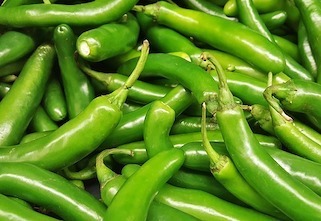
10,000 – 23,000 SHU
Serrano pepper facts:Native to MexicoCan substitute for jalapeño peppers in most dishes, and vice versa, though serranos are a bit hotterGrows 1 to 4 inches longUsually eaten raw, frequently in salsas, sauces, and relishesTry these serrano pepper recipes:Whole30 Baked Sticky Asian WingsSpicy Serrano Hot Sauce (fermented!)3. Habanero Peppers

100,000 – 350,000 SHU, but can be even hotter
Habanero pepper facts:Originally from South America but now grown mostly in MexicoCommonly used in Mexican and Central American cookingRelated to much spicier peppers like the ghost pepper and Scotch BonnetShort, plump fruit usually 1 to 2 inches longCome in a variety of interesting colors and flavors, from traditional orange-colored habanero to the dark purple-brown chocolate habaneroJust one habanero pepper delivers more than the recommended daily allowance of vitamin CTry these habanero pepper recipes:Habanero ChiliPeach Habanero Salsa4. Poblano Peppers

Ancho chili (when dried)
How hot are poblano peppers?1,000 – 2,000 SHU
Poblano pepper facts:Native to MexicoThe largest pepper on this list, growing 3 to 6 inches long and about 2 to 3 inches wideAlso the mildest pepper on this listUsually eaten cooked, not rawTry these poblano pepper recipes:White Chicken ChiliKeto Tex-Mex Stuffed Chicken BreastsChili Relleno Casserole5. Mirasol Peppers
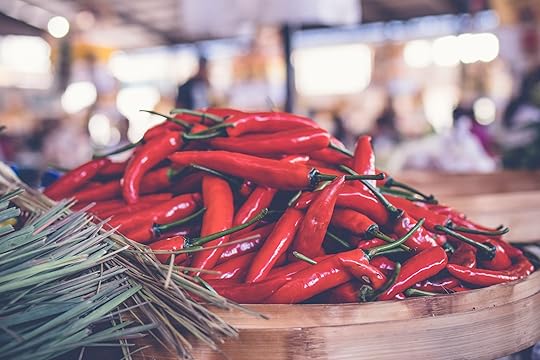
Guajillo chili (when dried), travieso chili
How hot are mirasol peppers?2,500 – 5,000 SHU
Mirasol pepper facts:Originally from MexicoAlso grown in Peru and popular in Peruvian cookingBright red, skinny pepper that grows 3 to 6 inches longOften used dried (as guajillo)Best known as a central ingredient in mole sauceTry these mirasol/guajillo pepper recipes:Carne AdobadaSmoky Guajillo SalsaClassic Ground Beef with Guajillo Chiles6. Cayenne Peppers

30,000 – 50,000 SHU
Cayenne pepper facts:Native to French GuyanaBright red, skinny, curve pepper that grows 2 to 5 inches longMost often used in dried and ground form to bring the heat to a wide variety of dishes and cuisinesThe “red pepper flakes” you buy at the grocery store or sprinkle on your pizza are most likely cayenne peppersTry these cayenne pepper recipes:Hot Chili Pepper TrufflesHomemade Cayenne Pepper Sauce7. Thai Chilis

50,000 – 100,000 SHU
Thai chili facts:The term “Thai chili” may refer to many different species, most often bird’s eye chilisSkinny, deep red fruit measuring 1 to 2 inches longUsed both fresh and dried in chili pastes, sauces, stews, and curriesTry these Thai chili recipes:Whole Roasted Green Curry Chicken in Coconut MilkSesame Chicken and “Rice” with Fiery Ginger and Chile SauceTom Yum Soup8. Scotch Bonnets
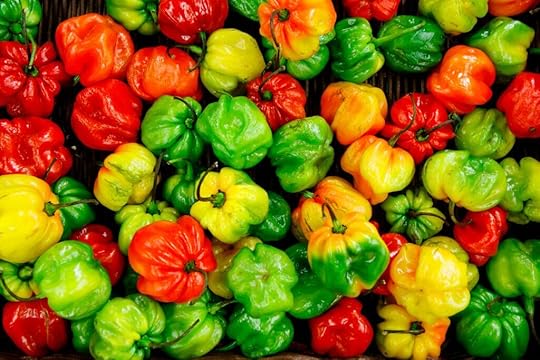
Caribbean red peppers, bonney peppers, goat peppers, githeyo mirus
How hot are Scotch bonnets?100,000 – 350,000 SHU
Scotch bonnet facts:Native to the CaribbeanAlso popular in the MaldivesShort, roundish pepper grows 1 to 2 inches longSo named for its resemblance to Scottish tam o’ shanter hatsTraditionally used to make Jamaican jerk seasoningTry these Scotch bonnet recipes:Poul Ak Nwa (Cashew Chicken)Jamaican Jerk Sauce9. Ghost Peppers

Bhut jolokia
How hot are Ghost bonnets?855,000 – more than 1 million SHU
Ghost pepper facts:Native to northeast IndiaRed, yellow, orange, or brown pepper 2 to 3 inches in lengthOnce considered the world’s hottest pepper, but has since been beaten by the Trinidad scorpion pepper and the Carolina ReaperFirst pepper to be measured over 1 million SHUUsed by the Indian military in “chili grenades”Try these ghost pepper recipes:Ghost Pepper WingsGhost Pepper SalsaChili Salt10. Carolina Reapers

1.4 million to 2.2 Million SHU
Carolina Reaper facts:Wrinkly, roundish red pepper measuring 2 to 3 inches long with a pointed tailCreated by Ed Currie of the Puckerbutt Pepper Company (yes, really)Currently holds the world record for hottest pepper (as of October, 2021)Can cause severe burns if eaten raw or handled with bare handsTry these Carolina Reaper recipes:Are you serious? Don’t try this at home!
Let us know in the comments: What’s the hottest thing you’ve ever eaten? Do you have a favorite chili that didn’t make the list? Maybe the hearty Anaheim, guindilla verde, or aji amarillo?
References https://www.sciencedirect.com/science/article/pii/S1389041720300772https://www.ncbi.nlm.nih.gov/pmc/articles/PMC6273101/https://pubmed.ncbi.nlm.nih.gov/26093270/ (function($) { $("#dfETth4").load("https://www.marksdailyapple.com/wp-ad..." ); })( jQuery ); 
The post A Visual Guide to Peppers appeared first on Mark's Daily Apple.



October 1, 2021
New and Noteworthy: What I Read This Week—Edition 148
 Research of the Week
Research of the Week
Compared to vegetable fat high in artificial trans-fatty acids (and a control diet), ruminant fat high in natural trans-fatty acids improves liver health, gut biome, and inflammatory status of lab rats.
Reasonable, accessible stack for COVID.
Selenium deficiency is implicated in viral myocarditis.
Energy compensation after exercise varies between individuals and may predict adiposity.
Too many omega-6 fats, increased risk of peripheral nerve pain.
New Primal Blueprint PodcastsEpisode 500: Mark Sisson and Elle Russ: Elle and I get together for the final Primal Blueprint Podcast. Elle is launching her own podcast, and the Primal Blueprint Podcast will become the Primal Kitchen Podcast, hosted by CEO and co-founder Morgan Zanotti.
Health Coach Radio: Dr. Ashley Lucas stresses that big change takes time.
Media, Schmedia
Why the Giant Sequoia needs fire.
Interesting Blog PostsOne hundred years of diet-heart research.
Social NotesCorporate funding for the AHA and ADA.
Everything ElseHow many times have we heard about some “vertical farm” system that will render all other forms of farming obsolete?
Isn’t a “sword-wielding man dressed as a ninja” who attacks and wounds several Special Forces soldiers just a ninja?
Things I’m Up to and Interested InThis is why I suggest everyone spend at least some time in ketosis on a regular basis: It’s probably very good for aging brains.
Now this is a list of food for kids: What are the most nutrient-dense foods for kids in South and Southeast Asia?
Interesting article: A new story of the peopling of the Americas.
Curious study: What happens to patient deaths when doctors go on strike?
Powerful imagery: Different ways to reach 1600 calories.
Question I’m AskingIf the Giant Sequoia needs fire to grow, what do you need?
Recipe CornerIt’s about that time. Paleo apple crisp time.One pot meals are extremely convenient. This creamy Tuscan chicken is no exception.Time CapsuleOne year ago (Sep 25 – Oct 1)
Why It’s So Hard to Ditch Grains (When Everyone Else is Eating Them) — Well, why?What Are the Best Probiotic Strains?— What are they?Comment of the Week
“I’ve definently experienced this but the other way around as a european travelling to the US. I felt like I was being rushed at the restaurant and expected to inhale my food in 30 min. Also I couldn’t really walk anywhere so I was basically sitting in a car or in a house(and felt terrible because of it). It felt so odd that if I wanted to go for a walk I had to first drive to a place where I could walk. And then drive back. I was also shocked when I bought butter for my bread at the grocery store and when I opened the butter it was WHITE. Snow white. The fat on the meat was the same. Snow white.
Given that this was just a snap shot of one place in the US but if I would compare that place(small town in Ohio) with my home town I can say for sure it is so much easier to live a healthy lifestyle in Sweden than in the US. I bet you can live well in the US too but it takes more effort(and probably more money).”
-I will respond to this in this week’s Sunday with Sisson.
(function($) { $("#dfOwiyk").load("https://www.marksdailyapple.com/wp-ad..." ); })( jQuery ); 
The post New and Noteworthy: What I Read This Week—Edition 148 appeared first on Mark's Daily Apple.



Mark Sisson's Blog
- Mark Sisson's profile
- 199 followers



